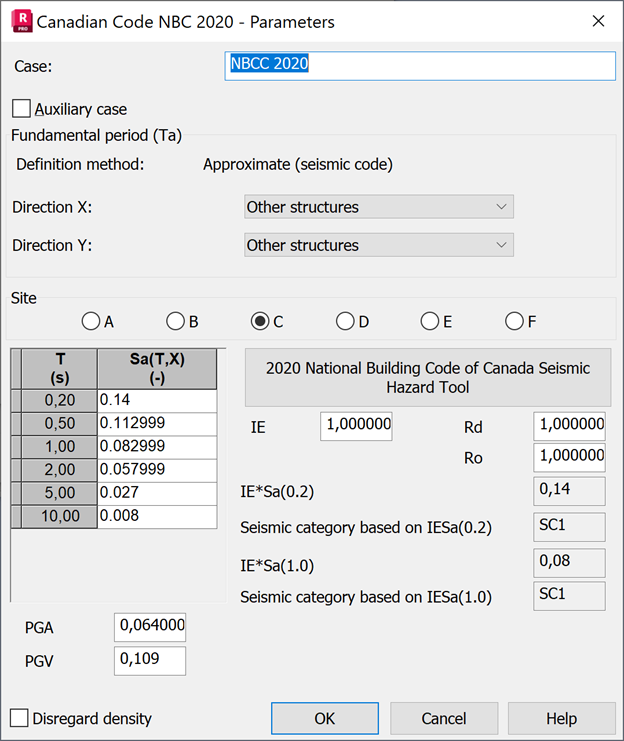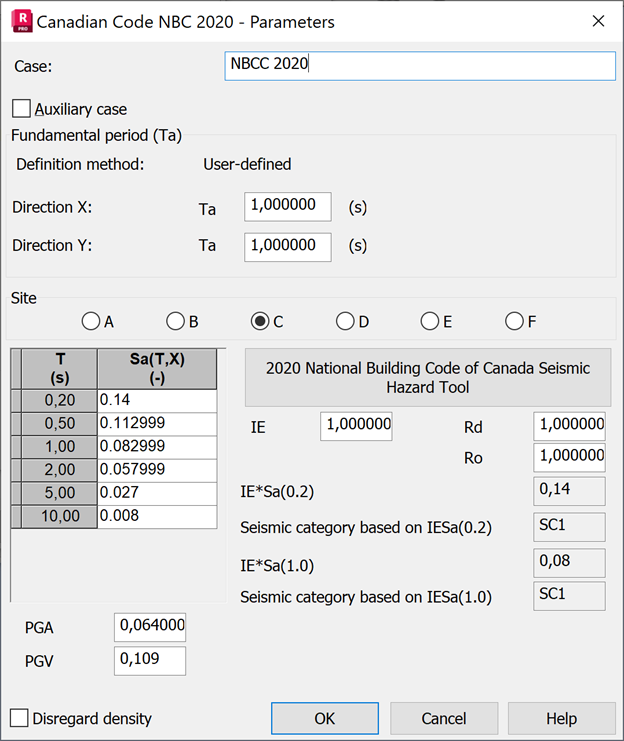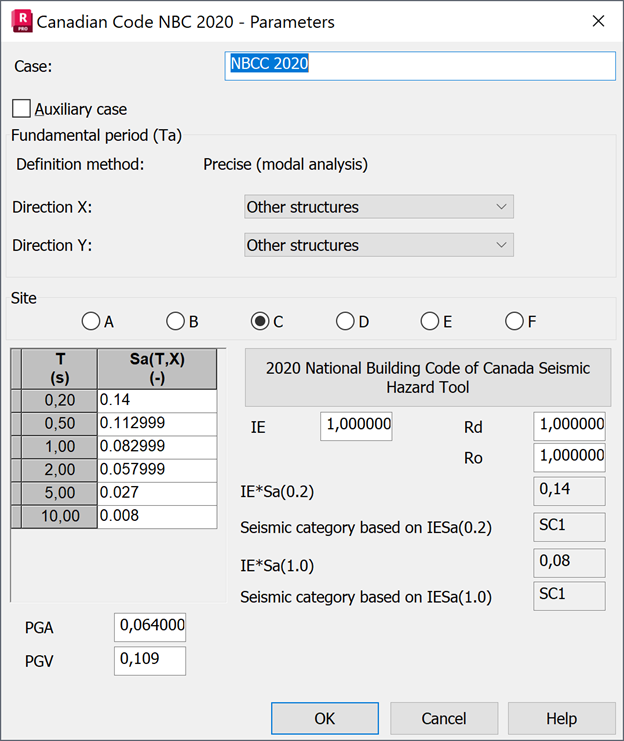The parameters of the seismic simplified analysis according to the equivalent lateral force method depend on a seismic code and a method of defining the values of the fundamental periods selected in the Seismic Analysis dialog.
- Braced frames.
- Coupled walls.
- Other frames (other moment resisting frames).
- Other structures (other systems).
- RC frames (concrete moment resisting frames).
- Steel frames (steel moment resisting frames).
- Wall-frame systems.
- Walls.
Approximate method

The fundamental period (Ta) depends on the structure type, and on its effective height (hn). It is calculated according to point 4.1.8.11.3.
User-defined method

The fundamental period (Ta) may be defined by a user in both global directions X and Y. No restrictions are applied to user-defined values.
Precise method

In this method a modal analysis case is created. Fundamental period is calculated for both X and Y directions.
- If the option "Periods with maximal mass participation" is off in the Seismic Analysis dialog, then the first mode in direction where are participating masses is taken as fundamental period.
- If this option is on, fundamental period is taken from the mode, which fulfill limitations and gives the maximum participating masses in the direction.
When the Precise Method is used, the fundamental period (Ta) is expected to be following the results of Modal Analysis, but it will be verified against the limits provided in design code in point 4.1.8.11.(3d). The limits of fundamental period (Ta) depend on the structure type and on the results obtained with the approximate formulas.
Code parameters
The code parameters for a seismic analysis according to NBC 2020 are defined as follows:
-
Site classifications for ground (A, B, C, D, E, F) are conform with the Table 4.1.8.4.-A and 4.1.8.-B.
- Spectrum
You need to specify spectrum values Sa(0.2), Sa(0.5), Sa(1.0), Sa(2.0), Sa(5.0), Sa(10.0) in accordance to Article 4.1.8.1 for the site location.
It is possible to access official NBCC website: 2020 National Building Code of Canada Seismic Hazard Tool by clicking the button. This page allows to obtain values required for defining the spectrum and coefficient values based on basic data such as location and site soil class. To transfer the values from the spectrum definition table on the webpage to the definition table in the Robot Structural Analysis, the copy-paste operation can be used.
You may access and copy spectrum values in accordance to Article 4.1.8.1 - Sa(0.2), Sa(0.5), Sa(1.0), Sa(2.0), Sa(5.0), Sa(10.0) or additional values Sa(0.1), Sa(0.3). Spectrum values for a specific period S(Ta) is obtained by linear interpolation between these values.
- Coefficients:
-
IE (Importance factor) conforms with table 4.1.8.5-A.
-
Rd (ductility-related force modification factor) and Ro (overstrength-related force modification factor) factors conform with Table 4.1.8.9.
-
- Factors calculated for informative purpose
-
- Factor PGA - Peak Ground Acceleration, as defined in Sentence 4.1.8.4.(1).
- Factor PGV - Peak Ground Velocity, as defined in Sentence 4.1.8.4.(4).
- Value of IE*Sa(0.2) and corresponding Seismic Category for Buildings according to Table 4.1.8.5-B
- Value of IE*Sa(1.0) and corresponding Seismic Category for Buildings according to Table 4.1.8.5-B
Base shear force (V)
Base shear force (V) is calculated according to the formula 4.1.8.11.(2):
V = S(Ta) * Mv * Ie * W/(Rd * Ro)
- W is the seismic weight of the structure [N].
- Mv the Higher Mode factor depends on the fundamental period Ta . Mv value is interpolated linearly depending on ratio Sa(0.2)/Sa(5.0) for the specified lateral resisting system type. Depending on the structure type selected for the load case, the lateral resisting system type is assigned according to table 4.1.8.11:
-
- Braced frames - Braced frames
- Coupled walls - Coupled walls
- Other frames - Other systems
- Other structures - Other systems
- RC frames - Moment resisting frames
- Steel frames - Moment resisting frames
- Wall-frame systems - Walls, Wall-frame systems
- Walls - Walls, Wall-frame systems
- S(Ta) is linearly interpolated between values calculated according to the formulas below:
- S(T)=F(0.2) * Sa(0.2) or F(0.5) * Sa(0.5) for T <= 0.2 sec.
- S(T)=min(F(0.5) * Sa(0.5) for T = 0.5 sec.
- S(T)=Fv(1.0) * Sa(1.0) for T = 1.0 sec.
- S(T)=F (2.0) * Sa(2.0) for T = 2.0 sec.
- S(T)=F 10.0) * Sa(10.0) for T >= 10.0 sec.
Lateral earthquake force V should not be less that values specified in tables 4.1.8.11.(2 a-c).
Disregard density
Excludes the density of the structure element (ρ=0) during the estimation of effective seismic weight applied to the stories of the structural model during analysis.
In this case you need to apply added masses or loads conversion to masses as defined in Load Types dialog at Load to Mass Conversion tab.
You can examine all the input parameters and base shear force distribution in the Calculation Notes (open Analysis > Calculation Notes > Simplified/Full Note)